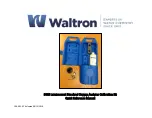
Version 1
25
To do this:
a. Touch upstream of the valve and gradually rotate Frequency Select Dial until the stray signals are
minimized or until the desired fluid flow is heard clearly.
b. Touch the upstream side, valve seat, downstream sides ( as described above) and compare differences.
Confirming Valve Leakage in Noisy Pipe Systems
Occasionally in high pressure systems, stray signals occur from valves that are close by or from pipes (or
conduits) feeding into a common pipe that is near the downstream side of a valve. This flow may produce false leak
signals. In order to determine if the loud signal on the downstream side is coming from a valve leak or from some
other source:
1. Move close to the suspected source (i.e., the conduit or the other valve).
2. Touch at the upstream side of the suspected source.
3. Reduce sensitivity until the meter displays a mid-line ("50") reading.
4. Touch at short intervals ( such as every 6 - 12 inches (15-30.5 cm) and note the meter changes.
5. If the sound level decreases as you move towards the test valve, it indicates that the valve is not leaking.
6. If the sound level increases as you approach the test valve, it Is an indication of a leak in the valve.
Miscellaneous Problem Areas
Underground Leaks
Underground leak detection depends upon the amount of ultrasound generated by the particular leak. Some slow
leaks will emit very little ultrasound. Compounding the problem is the fact that earth will tend to insulate ultrasound.
In addition, loose soil will absorb more ultrasound than firm soil. If the leak is close to the surface and is gross in
nature, it will be quickly detected. The more subtle leaks can also be detected but with some additional effort. In
some instances it will be necessary to build up pressure in
the line to generate greater flow and more ultrasound. In
other cases it will be necessary to drain the pipe area in question, isolate the area by valving it off and inject a gas
(air or nitrogen) to generate ultrasound through the leak site. This latter method has proven very successful. It is
also possible to inject a test gas into the test area of the pipe without draining it. As the pressurized gas moves
through the liquid into the leak site, it produces a crackling sound which may be detected.
Procedure
1. Use contact (stethoscope) module.
2. Touch surface over ground, DO NOT JAM probe to ground. Jamming can cause probe damage,
a. In some instances it will be necessary to get close to the "source" of the leak. In this
situation, use a thin, sturdy metal rod and drive it down close to, but not touching, the pipe.
b. Touch the contact probe to the metal rod and listen for the leak sound.
c. This should be repeated approximately every meter until the leak sound is heard.
d.
To locate the leak area, gradually position the rod until the leak sound is heard at its loudest
point. An alternative to this is to use a flat metal disc or coin and drop it on the test area.
Touch the disc and listen at 20 kHz. This is useful when testing concrete or asphalt to
eliminate scratching sounds caused by slight movements of the stethoscope module on
these surfaces.









































